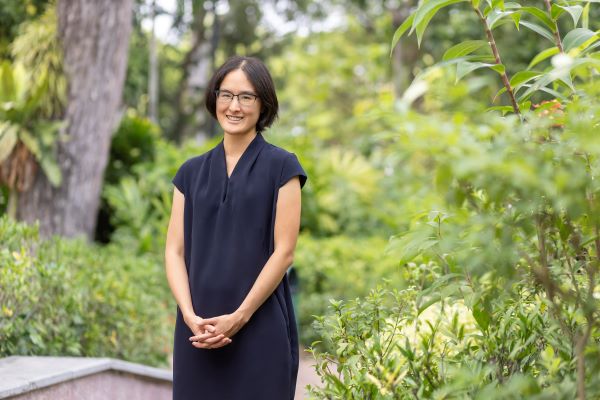
By Christie Loh
SMU Office of Research – At first glance, the pages of the notebook appear to be filled with swirls and curlicues sitting primly within each ruled line. It could be a computer printout of some whimsical font. On closer inspection, however, you will discover that this is someone’s meticulous handwriting in a personal notebook of thoughts and ideas.
Meet Assistant Professor Jacqueline Ho, the newest sociologist at the Singapore Management University’s (SMU) School of Social Sciences. She came in at the start of the year, after completing her PhD at Cornell University in the United States, and is currently teaching an undergraduate course, “Sociology of Education”.
Education – particularly in Singapore – is close to Professor Ho’s heart. The 33-year-old Singaporean went through the local school system until she left for the US to pursue her undergraduate degree at Brown University.
“Having grown up here, I experienced inequalities in the education system,” Professor Ho told the Office of Research. On the more advantaged end of the education spectrum, she experienced smaller class sizes and access to more resources under the Gifted Education Programme. She became aware of how “privileged” her schooling experience was only later in life, especially when her close friends started teaching at “lower-performing schools” and had plenty of real-life stories to share. In addition, Teo You Yenn’s book about Singapore, “This is What Inequality Looks Like”, was published in 2018. The bestseller was “inspiring” and showed Professor Ho how a sociologist’s work could contribute to the national conversation about a weighty issue.
What is the buy-in for “Every School, A Good School”?
When it came to time for her PhD dissertation, Professor Ho zeroed in on a catch phrase that elicits much discussion among Singaporeans: “Every School, a Good School”. Articulated in 2012 by then-Education Minister Heng Swee Keat, it was a clarion call for Singaporean parents to look beyond academic records when picking a primary school for their 7-year-old children. This was followed by a slew of policy changes, such as no longer publishing the names and schools of top scorers in the Primary School Leaving Examination (PSLE) so that parents would not make a beeline for those schools. The general intention was to divert the usual spotlight on academically high-achieving schools – which would be over-subscribed and popular to the point that parents were willing to fork out more for housing physically near those schools – towards lesser-known schools that touted non-academic points in their favour. The desired result was a more ‘holistic’ approach to education, where parents would be less ‘kiasu’ (Singlish for “afraid to lose out”).
Has it changed parents’ minds? That was the question Professor Ho sought to answer in a chapter of her PhD dissertation, “Can Every School be a Good School? Educational Categories and the Limits of Unranking”, which was submitted in February to an academic journal.
For her research, she interviewed 50 parents in Singapore, most of whom were socioeconomically privileged, because “the literature on school choice in different countries suggests that middle-class parents are more actively involved in choosing schools for their children”, said Professor Ho. They are also “exactly the kind of parents whose minds the Singapore government has been trying to change, the sort of more kiasu parents.”
Let’s not shoot ‘kiasu’ parents
She discovered that most of the interviewed parents continued to perceive a ‘hierarchy’ of schools, instead of a ‘heterarchy’ of schools that each possessed unique strengths to meet different student needs. And the reason for this entrenched perception is, these parents’ lived experiences during school days have seared certain social categories into their minds. For some, choosing a suitable school is a way to shield their child from the stigma they felt earlier in life as a result of these categorical distinctions. For others, “good schools” are synonymous with “good students,” a category whose meaning they have learned through their experiences of being sorted by academic ability.
“When you hear policymakers talking about this issue, a lot of the blame is put on kiasu parents who only care about grades, and the solution is that there needs to be a mindset shift,” said Professor Ho. But “ultimately, the competition for primary schools reflects the societal divisions that are still very much with us and that has partly been a product of previous ranking practices in the school system.”
Therefore, “this process of unranking is also about thinking about how to undo categories, which are baked into everything,” she said. “The national conversation needs to be more about societal divisions and about segregation, than about just kiasu mindsets.”
How exactly this can be done, Professor Ho frankly admitted her uncertainty: “I struggle with coming up with a policy prescription because it’s such a massive societal issue. Also, some of these issues are not for the schools to solve.”
On the ground level, she said, parents who find it tough to jostle for a place in popular primary schools are using the idea of “Every School, A Good School” as a “salve”.
She explained: “I find that what the ‘Every School a Good School’ rhetoric is doing is, not so much convincing parents that every school is worthy in its own way, but more that it’s comforting to parents who can’t compete. It’s helping parents to exit the competition with more peace of mind, and less sense of guilt about whether they’re making the right choice for their kid.”
Up next: How stakeholders are responding to MOE’s new evaluation methods
Professor Ho is also working on another paper that looks at how school choice is a process of constructing an identity as a responsible parent, in addition to being simply a means of reproducing one’s class status. Separately, she plans to study the implications of MOE’s changes to the way students are assessed, and how educational stakeholders, such as parents, are coping with these shifts.
“The evaluation standards in our education system are in flux, as the Government has been trying to move away from a system that ranks students by their grades, to a system that values everybody for their own unique talents,” she said.
Basically, she added, this is an attempt to transform a hierarchy into a heterarchy. Inevitably, there are “tensions” in policy implementation, as some parents have outright voiced a preference for traditional examinations while others have welcomed the move.
“It is these tensions that I’m trying to understand better as a way to understand how to create a society that’s more heterarchical,” said Professor Ho. “As a sociologist, I want to uncover people’s lived realities on the ground.”
In a few years’ time, Professor Ho may find herself in the shoes of parents grappling with primary school registration for her son currently aged two. While it is not uncommon for parents to begin the planning process for their children at this age, Professor Ho cannot bring herself to do so just yet. She laughed, “We’re just trying to get through the day-to-day now, no time to plan for the future yet!”
Professor Ho moved back to Singapore last October with her husband, who is a data systems developer and the primary caregiver for their toddler. She chuckled merrily talking about how he has drawn up a list of the playgrounds they have visited, complete with details such as which time of day it is best to visit and whether there is an air-conditioned mall nearby for cooling down.
“All that is to say that we are mostly adjusted to life in Singapore,” Professor Ho said. And whether she is on campus or at the playground, she usually has pen and paper on hand to jot down any ideas. Just take a look at her notebook.
Back to Research@SMU February 2025 Issue
See More News
Want to see more of SMU Research?
Sign up for Research@SMU e-newslettter to know more about our research and research-related events!
If you would like to remove yourself from all our mailing list, please visit https://eservices.smu.edu.sg/internet/DNC/Default.aspx
